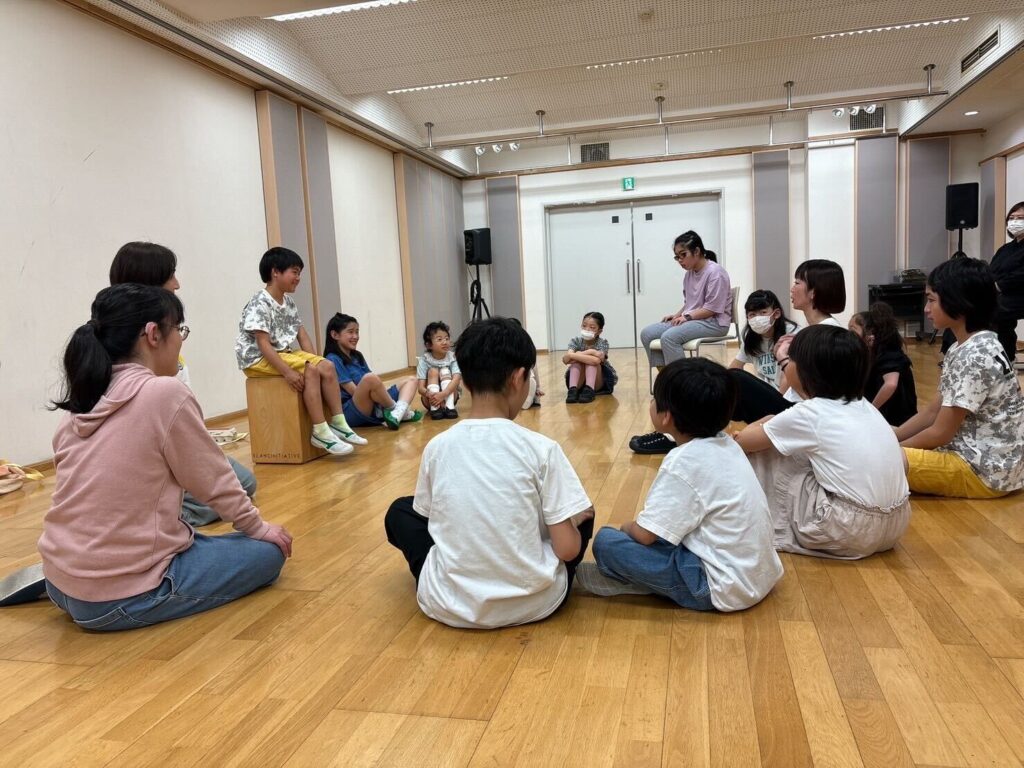
※Classe de l’espritは(小学4年生以上を対象にした)DUMIのクラス名です。
※ろう者も参加するDUMI音楽ワークショップには、手話通訳が必ずサポートに入ります。
テーマ:Silence(静けさ・小さな音)
時間:10:30〜11:30
(手話通訳:田家先生 アシスタント:戸村めぐみ)
この日の「Classe de l’esprit」では、“静けさ”や“小さなな音”に耳をすませたり、静かな空間をつくり出すといった五感をひらいて音とその空間に向き合う体験を行いました。日常では見過ごしてしまいがちな小さな音や空間、感触に意識を向けることで、心と身体の感覚を深めることを目指しました。
・感覚を研ぎ澄ます「木のたまご」
まずは簡単なウォーミングアップのあと、半円になって座り、自分自身の感覚に意識を向ける時間を持ちました。
2種類の木でできた卵型のオブジェを手に取り、視覚・嗅覚・触覚に集中します。
「色が違う」「重さや手ざわりが違う」といった気づきが子どもたちから自然に生まれ、静かな空間の中で集中力が高まっていく様子が印象的でした。また、子どもたちがたまごオブジェを隣の人に渡す時、非常に丁寧に優しく手渡していた姿が見られました。
・静かな空間、小さい音を工夫してつくる
次は、大きくふくらませたビニール袋を、できるだけ音を立てずに隣の人へ渡す活動へ。
足音・声・ビニールの擦れる音を抑えるため、子どもたちは慎重に体の使い方を工夫していました。
2周目には、あえて渡しづらくなるような動きを取り入れ、難易度が上がる中でも、楽しさと集中が共存する空間が生まれました。
忍び足になったり、手の動かし方を変えたりする姿も見られ、静けさを保つことに真剣に取り組むと同時に、目に動き顔の表情も段々と豊かになっていきました。
・聴いて、触って、想像する「音のお手玉」
続いて登場したのは、さまざまな素材が詰まったお手玉(sac à son)。
ストローやピスタチオの殻など、中に何が入っているのかを音や手触りから想像します。
「種?」「つけ爪?」「米粒?」「ネイル?」「土に埋めて育てれば中身がわかるかも」と、子どもたちは自由な発想で推測しながら、
振る・擦る・落とす・耳元で聴くなど、音の出し方を工夫して試していました。
・カホンでリズムを感じる
最後は、カホンという打楽器を使ってリズムの体験へ。1人ずつカホンに座り、4回叩いてその振動を感じ取ります。
「お尻に振動が来た」「心臓に響いた」「びっくりした」といった、音の“身体への作用”に関する感想が出ました。
次に、カホンのリズムに合わせて「4歩歩く→4拍休む」を繰り返す動きを体験。
2グループに分かれて向かい合って歩き、タイミングを合わせたり、すれ違ったりすることで、自然と協調性も育まれていきました。
なぜか子どもたち全員が大股で歩き出すという微笑ましくも興味深い場面もありました。
最後には、初対面の女の子4人がカホンを囲み、相談しながら1拍ずつ順番に演奏。
互いを見て、聴いて、合わせるというリズムの対話が生まれました。

・まとめ:静けさの中にある自由と創造
この日の活動では、「音を出す」ことだけでなく、「静かにする」「音を聴く」ことの難しさと豊かさを味わいました。 制限があるからこそ生まれる集中と工夫、そして他者との関わりの中で広がる表現。
子どもたちはそれぞれのペースで、静けさの中にある音の世界と出会っていました。
Classe de l’esprit is the name of DUMI’s class for children in 4th grade and above.
All DUMI music workshops that include Deaf participants are supported by a sign language interpreter.
Theme: Silence (Stillness and Subtle Sounds)
Time: 10:30–11:30
(Sign Language Interpreter: Ms. Taie / Assistant: Megumi Tomura)
In this session of Classe de l’esprit, participants opened their senses to explore both sound and space through the theme of “silence” and “subtle sounds.”
By shifting their awareness to small sounds, quiet spaces, and textures often overlooked in everyday life, the children deepened their connection to both body and mind.
● Sharpening the Senses with Wooden Eggs
The session began with sensory observation using egg-shaped objects made from two different types of wood.
Participants engaged their senses of sight, smell, and touch to notice differences in color, weight, and texture.
Even those hesitant to speak at first gradually began to share their observations:
“The color is darker,” “It’s heavier,” “This one feels smooth; the other is rough,” and “There are more growth rings.”
This gentle process of noticing led to deeper focus and individual expression.
● Creating Silence and Small Sounds
Next came an activity where a large, inflated plastic bag was passed from one person to the next—without making a sound.
To avoid footsteps, voices, or the rustling of plastic, each participant carefully adjusted their body movements.
In the second round, added challenges made passing more difficult, yet the space remained filled with both concentration and playfulness.
Some moved stealthily, others changed the way they used their hands, and gradually their facial expressions and physical awareness became more animated.
The group worked seriously, yet joyfully, to maintain silence.
● Listening, Touching, Imagining: Sound Beanbags
The next experience featured sac à son—sound beanbags filled with a variety of materials like straws and pistachio shells.
Using touch and sound, children tried to guess what was inside:
“Seeds?” “Fake nails?” “Rice grains?” “Maybe we could plant it and find out what it is!”
They experimented with shaking, rubbing, dropping, and listening closely—exploring different ways to bring out sound while letting their imaginations roam freely.
● Feeling Rhythm with the Cajón
The final activity involved sitting on a cajón (box drum) and feeling rhythm through the body.
Each child took a turn playing four beats and noticing the vibrations.
Comments included: “I felt it in my seat,” “It echoed in my chest,” “That surprised me!”
Then they practiced walking four steps to the rhythm, followed by a four-beat rest.
In two facing groups, they walked toward each other, passed by, and adjusted timing—naturally developing a sense of coordination and cooperation.
A memorable and charming moment occurred when all the children spontaneously began taking large strides.
To conclude, four girls who had just met formed a small circle around one cajón, playing one beat at a time in turn.
They listened, watched, and adjusted to one another—creating a beautiful rhythm in dialogue.
● In Conclusion: Freedom and Creativity Within Silence
This day’s session offered not only the act of “producing sound,” but also the opportunity to explore the difficulty and richness of “being silent” and “listening.”
From limitations came focus, invention, and expression that grew through connection with others.
Each child, in their own way, encountered the world of sound within silence.


